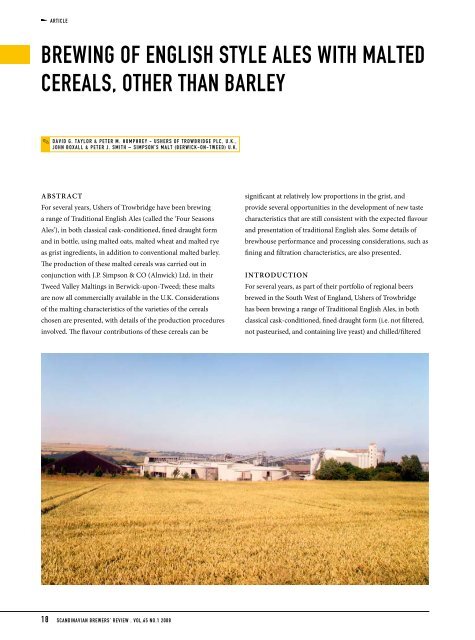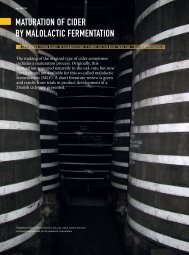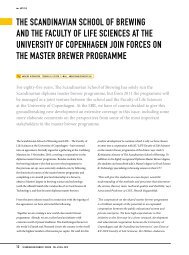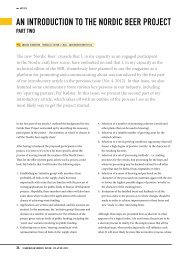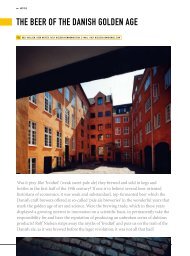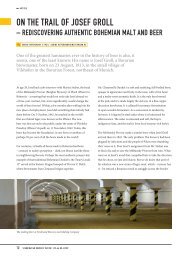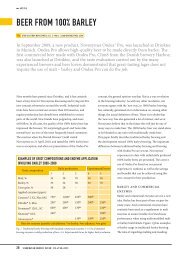BreWiNG OF eNGliSH StYle aleS WitH MalteD ... - Scandbrewrev.dk
BreWiNG OF eNGliSH StYle aleS WitH MalteD ... - Scandbrewrev.dk
BreWiNG OF eNGliSH StYle aleS WitH MalteD ... - Scandbrewrev.dk
You also want an ePaper? Increase the reach of your titles
YUMPU automatically turns print PDFs into web optimized ePapers that Google loves.
articleBREWING <strong>OF</strong> ENGLISH STYLE ALES WITH MALTEDCEREALS, OTHER THAN BARLEYD a v i d G . T a y l o r & P e t e r M . H u m p h r e y - U s h e r s o f T r o w b r i d g e p l c , U . K . ,J o h n B o x a l l & P e t e r J . S m i t h – S i m p s o n ’ s M a l t ( B e r w i c k - o n - T w e e d ) U . K .ABSTRACTFor several years, Ushers of Trowbridge have been brewinga range of Traditional English Ales (called the ‘Four SeasonsAles’), in both classical cask-conditioned, fined draught formand in bottle, using malted oats, malted wheat and malted ryeas grist ingredients, in addition to conventional malted barley.The production of these malted cereals was carried out inconjunction with J.P. Simpson & CO (Alnwick) Ltd. in theirTweed Valley Maltings in Berwick-upon-Tweed; these maltsare now all commercially available in the U.K. Considerationsof the malting characteristics of the varieties of the cerealschosen are presented, with details of the production proceduresinvolved. The flavour contributions of these cereals can besignificant at relatively low proportions in the grist, andprovide several opportunities in the development of new tastecharacteristics that are still consistent with the expected flavourand presentation of traditional English ales. Some details ofbrewhouse performance and processing considerations, such asfining and filtration characteristics, are also presented.INTRODUCTIONFor several years, as part of their portfolio of regional beersbrewed in the South West of England, Ushers of Trowbridgehas been brewing a range of Traditional English Ales, in bothclassical cask-conditioned, fined draught form (i.e. not filtered,not pasteurised, and containing live yeast) and chilled/filtered18 SCANDINAVIAN BREWERS’ REVIEW . VOL.65 NO.1 2008
B R E W I N G O F E N G L I S H S T Y L E A L E S W I T H M A L T E D C E R E A L S …in bottle, using malted cereals other than barley in the gristcompositions. Alternative cereals are, of course, used verysuccessfully as adjuncts in many beers. Indeed, several beerbrands use rice and maize as grits, but cereal cookers arerequired; very few U.K. brewing operations have cereal cookingfacilities. Further, unmalted sorghum and barley itself can besatisfactorily used, but usually require substantial additions ofenzymes (of fungal and/or bacterial origin) during mashing,with protracted mashing programmes, involving severalgraduated temperature changes. There are numerous instancesin which other cereals have been used in unmalted forms inspecialist applications, for example as flours or as pre-gelatinisedflaked products in a number of beers, such as, Oatmeal Stouts.Wheat flour (also in compressed pellet form) has been appliedto enhance head retention in several beer types.However, using unmalted cereals as grist adjuncts can presentcertain challenges, such as milling problems (especially withwet or steep-conditioning mills) and undesirable flavours mayarise from the ‘cooking’ conditions occurring during the flakingprocess.By using malted cereals, you avoid many of the potentiallynegative features and allow higher grist proportions to be usedwithout the need to consider the use of additional mashingenzymes. In addition, there is a certain element of provenanceassociated with malted cereals, which can be especiallyimportant in marketing considerations for beers such astraditional English cask ales.For these reasons, we have brewed with malted oats, maltedwheat and malted rye as part of our Seasonal Beers strategy(‘Four Seasons Ales’). There has been a close associationbetween Ushers and Simpson’s Malt for many years and anumber of pilot-scale brewing trials have previously beencarried out, using a range of malted cereal varieties producedby Simpson’s Malt. As a consequence of this collaboration, awide range of speciality malts are now commercially available.SELECTION CRITERIAThe selection of the cereals to be used in the range of beers tobe produced on a seasonal basis was more related to marketingstrategy than any considerations of seasonal availability orharvesting. Consequently, wheat was chosen for the summerbeer because of the established tradition of producing light,refreshing beers brewed with wheat in the summer. Rye has aclassical autumnal connotation, whereas oats have an obvious,albeit frivolous, association with springtime. More importantly,it had already been established through the joint pilot studiesthat Simpson’s could readily produce malts from these cerealsand had identified suitable varieties that were readily available,as follows:Oats - the winter variety – ‘Imagen’ (also selected because ofits larger grain size),Wheat - the winter variety – ‘Riband’ (a soft wheat, knownto malt satisfactorily for brewing, as well as used for breadmaking),Rye - the winter variety – ‘Halo’MALTING CHARACTERISTICSAn indication of the main compositional features of thesecereals in comparison with malting barley (U.K. 2-row) ispresented in Table l. The importance of these features on thecharacteristics of the malts produced is detailed below.Table 1 - Average Compositions (% by weight)Barley Oats Wheat RyeSoluble Carbohydrate 78 70 79 80Protein 12 11.5 14 13.5Lipid 2 5 2.5 2Fibre 5 10.5 2.5 2Mineral 3 3 2 2.5OatsThe relatively low carbohydrate content is reflected in low potentialextract and the high fibre content is a consequence of thehigh husk fraction (and small endosperm). The total nitrogenlevel is similar to barley (U.K. 2-row), but it is found that onlysome 10% remains permanently soluble. Further, oats have ahigh lipid content. The grain size is slightly longer than barley,but considerably narrower (approx. 1/2 the diameter).WheatWheat has a loose husk which is not retained during maltingand leads to rapid moisture uptake. The protein contents tendto be significantly higher than barley and, as a rule, modificationand friability are poorer with lower levels of free amino-nitrogen,although enzyme levels (especially amylolytic activities)tend to be higher with enhanced extracts. The grain size isapproximately the same as barley, but rounder.HALTING PROCEDURESSome of the key features employed in the malting proceduresare detailed below.SCANDINAVIAN BREWERS’ REVIEW . VOL.65 NO.1 2008 19
B R E W I N G O F E N G L I S H S T Y L E A L E S W I T H M A L T E D C E R E A L S …OatsA single water steeping schedule is all that is required toachieve sufficient moisture content (in excess of 42%),due to the thin nature of the grain. A staged germinationtemperature programme from 14°C to 18°C is used to ensureeven germination control. The green malt is turned every 8to 12 hours to achieve even acrospire growth. The kilningtemperature profile ramps from 50°C up to 80°C maximum.WheatTwo short steep water periods are used to attain the targetmoisture of greater than 42%. Additional water may be sprayedafter 24 hours germination to maintain moisture at over 42%.To ensure even germination, staged process temperatures areset at 12°C to 18°C.The green malt is turned gently (to avoid damage to theexposed acrospire, due to lack of husk) every 6 to 8 hours.The kilning temperature profile ramps from 50°C up to 85°C.RyeA single short water steep is used to attain greater than 41%moisture (water absorption is rapid, due to the lack of husk andsmall grain size). It is important to avoid oversleeping and todischarge the steep vessel rapidly after draining to prevent grainbridging. Similarly, it is important to avoid bed compactionduring germination and kilning.Germination process temperatures start at 17°C rising to 22°Cand the green malt is turned very gently (exposed acrospire)and frequently (every 4 to 6 hours).The kiln temperature profile ramps up to a maximum of 75°C,to avoid excessive colour development.BREWHOUSE PERFORMANCEThe key malt analyses are presented in Table 2 in comparisonwith the standard analysis achieved for Pale Ale Malt (usingU.K. 2-row barley, typically the winter variety - ‘Halcyon’).The relevance of these analytical parameters on brewhouseperformance is detailed below.Table 2 - Typical Malt AnalysisBarley Oats Wheat RyeDry Extract (LDK) 307 234 325 316Moisture (%) 3.5 3.0 5.0 4.4Colour (IoB) 4.5 2.5 3.0 7.5TN (%) 1.55 1.60 1.87 1.65TSN (%) 0.6 0.3 0.7 0.7SNR 39 18 38 42DP (IoB) 55 67 80 56OatsThe most noticeable feature is the relatively low extractrecovery; indeed, initially this was especially low in practicebecause it was not appreciated that the mill gap setting (on thesteep conditioning mill used) had to be reset to only 0.2 mm inorder to achieve a satisfactory grind of the very thin oat grain.As a consequence, in initial brews the Lauter runoff rate wasconsiderably increased, when it was anticipated that the highhusk content should actually improve mash runoff rates. Itwas found that the only partially ground oat grains were notachieving full starch breakdown and thus caused considerableincrease in wort viscosity.Milling performance had to be compromised between grindingoats sufficiently, but not grinding the malted barley fractiontoo finely; it was not practical in our brewhouse to mill the twograin types separately.Another feature of the malt analysis is the very low level ofnitrogen modification, leading to low malt soluble nitrogen(TSN) and low soluble nitrogen to total nitrogen ratio (SNR).After boiling, the soluble nitrogen content (i.e. permanentlysoluble nitrogen, PSN) drops by a further 50%, so that onlysome 10% of the original grain Tot l Nitrogen (TN) remainssoluble in wort.This potential dilution of wort soluble nitrogen (and potentiallyfree amino-nitrogen) did not cause any fermentation concernswith the ale yeast strain used, but this may be a factor to beconsidered in determining the proportion of malted oats ingrist compositions.20 SCANDINAVIAN BREWERS’ REVIEW . VOL.65 NO.1 2008
B R E W I N G O F E N G L I S H S T Y L E A L E S W I T H M A L T E D C E R E A L S …WheatIn contrast to oats, malted wheat has no husk and canlead to poor mash filtration at high grist levels (> 30%).However, controlled slow speed raking can achieve adequateLauter performance, although wort clarity may be slightlycompromised. Poorer wort clarity may also be influenced bythe higher protein (soluble nitrogen) content.Very high extract recoveries can be obtained from maltedwheat and the high enzyme levels, as indicated by DiastaticPower (DP), may also enhance the extract recovery obtainedfrom the malted barley portion of the grist.RyeLike wheat, malted rye has no husk and the impact on wortrunoff rates can be even more apparent, since the solublenitrogen content is similarly higher than barley. In addition,wort viscosity is also increased, probably from a higher B-glucanand/or pentosan content in rye.The smaller, and somewhat variable, grain size may also dictatethe adjunct level attainable. However, grist proportions at up to30% are achievable without too much impact on brewing cycletimes.Extract recovery from rye is also slightly enhanced over barley.One interesting feature of worts derived from malted rye isthe very red hue of the wort colour. Indeed, restricting colourdevelopment during kilning is an important malting controlparameter.EFFECTS ON BEER FLAVOURThe flavour contributions from these different cereals can besignificant, even at relatively low grist proportions. A review ofthe taste characteristics is presented below.crisp dry citrus and tangy afterpalate is apparent, which has adistinctly refreshing, mouth cleaning effect.These flavour characteristics are most noticeable in pale, lightflavoured products and the effects blend well with warm,golden coloured beers.RyeMalted rye has the most intense flavour effects of all thesecereals. Even at low levels (15%), a distinctiveminty/juicy palate and afterpalate are apparent.These flavour effects combine well with darker malt flavours,such as crystal malts, and the rich ruby red colours attainablewith rye can be successfully augmented with dark malt colours.INFLUENCES ON PROCESSINGCHARACTERISTICSHead RetentionOne key beer analytical parameter influenced by these differentcereals is Head Retention Value (HRV), as indicated in Table 3.The results presented were obtained by the NIBEM methodof analysis and refer to beers of approximately equivalentcomposition in terms of extract levels derived from the othercereals (20%), with other analytical parameters as indicated.It is apparent that malted wheat significantly enhances headforming ability, with malted rye to a lesser extent. This effect isalmost certainly a consequence of the higher protein contentand is in confirmation of previous experience of the beneficialcontribution of wheat to beer head retention.OatsA key flavour attribute provided by malted oats is a pronouncedtoasted, biscuity aroma and palate, combined with a creamyand relatively intense mouthfeel.These flavour effects can be apparent at less than 10%replacement of barley in the grist, depending on the overallstrength of flavour.These flavour attributes blend especially successfully with strawyellow coloured beers.WheatEven at high grist levels (up to 50% ), malted wheat has themost neutral flavour effects of the cereals considered. Overall,there is little influence on aroma, but a creamy, soft palateeffect can be obtained. At slightly higher grist levels (>20%), aTable 3 - Influence on Head Retention – NIBEM MethodHRV: - Malted Barley (100%) : 250 secs- Oat Beer : 245 secs- Wheat Beer : 300 secs- Rye Beer : 265 secsOatsThe slightly reduced HRV seen in Oat beer is almost certainlyrelated to the lower soluble nitrogen content present and isprobably not related to the high lipid content of the oats (themajor portion of which is probably retained in the spent grainsafter lautering). This point is further supported by the observationthat there is no reduction in flavour stability detected in22 SCANDINAVIAN BREWERS’ REVIEW . VOL.65 NO.1 2008
B R E W I N G O F E N G L I S H S T Y L E A L E S W I T H M A L T E D C E R E A L S …oat beer, in comparison with equivalent products (up to 12months storage in bottle).WheatTwo processing features of wheat beer noted are as follows:- in the cask conditioned beer, it was found that finingperformance was somewhat poorer and that a higheraddition rate of silicate auxiliary finings was required (i.e.additional protein precipitant was needed).- there was a potential for reduced haze stability in the chilled/filtered wheat beers, which necessitated a higher degree ofchill-proofing treatment.RyeThe rye beers had good fining ability in cask conditioned form,but poorer filtration performance was noted in the chilled/filtered beer, due to increased viscosity. However, excellent hazeand flavour stabilities were obtained.However, it is perfectly clear that we are actually guilty ofreinventing the wheel, since we have merely re-learnt howto malt and brew with ingredients used by our forebears.Nevertheless, the flavour characteristics offered by using extractmaterials other than barley, either individually or blended oreven mixed with more aromatic flavourants, such as honey,ginger, orange zest or coriander, means that there is virtually nolimit to the range of new taste experiences available.Even just within the realm of alternative malted cereals, thereare a number of flavour and beer presentation opportunitiesto be realised. For the future, many options can be exploredand already maltsters are making an ever increasing range ofspeciality malts. Certainly, the cereals studied here are alsoavailable as aromatic malted variants and as various colouredmalts, such as Crystals, Ambers, Browns, etc.There is now no excuse for not providing an ever moreexperimental drinking public with the chances to sample a widerrange of taste experiences, but still legitimately defined as beer.CONCLUSIONSThe original objective of evaluating the possible developmentof new flavours in traditional English style ales by the use ofother malted cereals has been achieved and indeed severalnew product opportunities have arisen and more can still beenvisaged.ACKNOWLEDGEMENTSThe authors wish to express their appreciation to the Directorsof Ushers of Trowbridge plc and of J.P. Simpson & CO(Alnwick) Ltd. for their permission to publish this paper.SCANDINAVIAN BREWERS’ REVIEW . VOL.65 NO.1 2008 23


